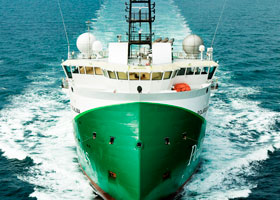Recently, the potential of the Northern Sea Route (NSR) as the shortest Eurasian route has become of a great interest for maritime companies in many countries. As a result, Russia has a great chance to implement one of the four priorities of its Arctic strategy - to ensure the organization of the NSR exploitation for international navigation within its jurisdiction and in compliance with international treaties. [1]
The era of Arctic shipping: first results
The systematic use of the NSR by foreign shipping companies was launched in 2009, when two vessels of the German company “Beluga Group” delivered about 5 tons of commercial cargo from Pusan (South Korea) to the New Port, located in the Gulf of Ob. Since then, the demand for NSR use has increased. From 115 tons (including 45 tons by foreign companies) of cargo transported trough the Arctic in 2010, by the end of the polar navigation in 2011 it has increased to 674 thousand tons, with the share of foreign carriers of almost 500 thousand tons.
If the functioning of Arctic marine transportation system proves to be profitable, it will be able to provide a synergic effect on the development of related industries, as well as to encourage the development of infrastructure in Russian regions along the entire Arctic Ocean coast.
The outlook for the near future is even more optimistic: according to the estimates of the Ministry of Economic Development of the Murmansk region in 2012 NSR will be able to transport in transit more than 1.5 million tons of bulk cargo and around one million tons of oil. In its turn, "Atomflot", the operator of the national icebreaker fleet, declares its readiness to provide the wiring of any number of ships along the Arctic sea routes. Such an accelerated rate of NSR exploitation is particularly impressive against the backdrop of previously made modest statements. For example, in 2008 "Soyuzmorniiproekt" predicted that the volume of cargo transit along the NSR would be able to reach 200 thousand tons only by the year 2020. And providing the intensive development of oil and gas fields of the Arctic shelf, as well as ore reserves and forest-industrial complex, it will be even higher. [2]
The expansion of foreign participation as a strategic priority for the development of NSR
Russia should urgently develop a flexible mechanism for rapid decision-making, which would eliminate all costs associated with obtaining the permission for the NSR use.
The State policy for the long-term development of the Arctic maritime transportation system should be aimed at achieving one goal - to ensure sustainable economic performance of NSR. If the functioning of the Arctic maritime transportation system is profitable, it will be able to produce a synergic effect on the development of related industries (oil and gas production, mining of ore minerals), as well as encourage the development of infrastructure in the Russian regions along the entire coast of the Arctic Ocean.
For the realization of this project, it is necessary to maximize the demand for NSR by international shipping companies, because the more transit transportation there will be in the Arctic, the bigger will be the amount of revenues received from the fees, imposed on freighters.
Here, we should take into consideration, that even with all its uniqueness, the shortest routes through the Arctic may not be interesting to all shipping companies. Consequently, when determining the target audience for NSR, there should be formulated relevant selection criteria. These are the following:
- inter-regional / global nature of its business;
- specialization (complete or partial) in freight transportation through Europe and Asia, or the desire to begin the development of the Asian / European market;
- presence in the fleet of ice-class vessels (at least 1A on the classification of Det Norske Veritas), and / or displacement of not less than 10 tons
Furthermore, there should also be taken into account a number of subjective factors: comments and statements of the principal executives of the company about NSR; cooperation with classification societies; support and participation in specialized conferences, such as the Polar Shipping Summit.
Applying the above criteria for determining the number of NSR users, we will have the list with a broad geography. In addition to the officially recognized polar states (Finland, Sweden, Norway, Denmark), it will include companies from Greece, Poland, Germany, the Netherlands and Belgium. In Asia, there is an interest in NSR from ship owners in South Korea, Japan and China. For example, among the foreign companies which intend to apply for the usage of NSR in 2012-2014 there are such companies as German «Oldendorff Carriers», «Hyundai Merchant Marine» from South Korea and Norwegian «Knutsen OAS Shipping». The whole list of stakeholders, of course, will be much longer.
True problems of NSR in international perspective
Despite the huge potential, the development of international shipping along the NSR is constrained by some obstacles.
The first and most important obstacle pointed out by all foreign shipping companies is the lack of feedback from the competent government structures of Russia, and above all, from the NSR administration. There is too much time spent on updating and coordinating the working moments, obtaining additional information about the route, going through all bureaucratic procedures. It is obvious that the Russian side has to urgently develop a flexible mechanism of rapid decision-making, which would eliminate all the costs associated with obtaining the permission for the NSR use. The same applies to the coordination of tariffs.
The second problem is that the perception of NSR by international shipping industry is still ambiguous and might change for the better or for the worse. But it is the image that plays the crucial role in the final decision making process of the freighter, while he is deciding which route to choose: the NSR or the well-known Suez Canal.
It is obvious that the Russian side should take additional efforts to increase the attractiveness of the NSR abroad. In this regard, the government structures may be faced with a number of urgent foreign policy problems.
The NSR administration can run into the following objectives: identification and individually tailored work with foreign shipping companies, as well as other economic entities which are potentially interested in using the NSR; presentation of current the NSR capabilities and capacities at the leading industry trade shows, seminars, conferences (for example, the North-Shipping, Polar Shipping Summit).
The Ministry of Foreign Affairs of the Russian Federation could hold consultations with foreign governments regarding their participation in the development of NSR (this problem is the most acute in case of China, where the shipping industry is predominantly controlled by the state), as well as the approval and enforcement of international recognition of the Russian Federation rights to the independent tariff policy in the Arctic (especially in view of Russia's membership in the WTO).
The prospects of NSR as an alternative Eurasian route
The transformation of NSR into a regular sea route gives Russia not only economic, but also significant political benefit.
Taking into account the dynamics of the development and the opportunities provided by NSR, we can assume that in the next few years, this route will be in demand mainly by small and medium-sized shipping companies, mostly in Europe. Their participation in the development of the route will serve as a kind of "core" armor piercing distrust to the transit potential of the Russian Arctic.
Achieving a sustainable demand for NSR will lead in the future to very positive results.
First of all, there will be created favorable conditions for including in the process of NSR development the leading players in shipping business, such as “Maersk” (Denmark), “Hapag-Lloyd” (Germany), “Golden Ocean” (Norway). Since the major freighters are working on long-term contracts, redirecting even a small part of their turnover from the well-established routes in the Arctic is associated with risks and reformatting traffic patterns. Therefore, a positive decision on this issue requires time and sufficient reasons.
Secondly, there will be geographic expansion of demand for NSR due to attracting Asian firms - South Korean «Hyundai Merchant Marine», China’s COSCO and the Japan’s "Big Three» - MOL, NYK and K Line. These firms still biding their time waiting for the opportunity to use NSR, but they are monitoring the project closely and will be ready to join it as soon as it is deemed necessary.
Thirdly, there will be a gradual extension of the polar navigation time. The first step towards this would be the organization of pilot commercial flights in the months preceding or following the summer Arctic navigation, which lasts from July to October - for example, in May / June or November / December. A successful implementation of this project will bring about the continuity of transit service between the European and Asian markets through the Arctic.
In addition, the transformation of NSR into a regular sea route promises to Russia not only economic, but also significant political benefits, which are necessary to strengthen the position of our country, not only in the Arctic, but also in the international arena. Turning the NSR into the demanded and permanent Euro-Asian transport artery, Russia will take a central place in the international maritime trade, which is especially important in the context of its accession to WTO.
1. Principles of State Policy of the Russian Federation in the Arctic for the period up to 2020 and further prospects / / Rossiyskaya Gazeta, 27.03.2009.
2. Hydrometeorological support of the Arctic navigation in the XX century and at the beginning of the XXI century / Ed. I. Frolova and B. Krutskih. St. Petersburg., 2008. S. 148.







